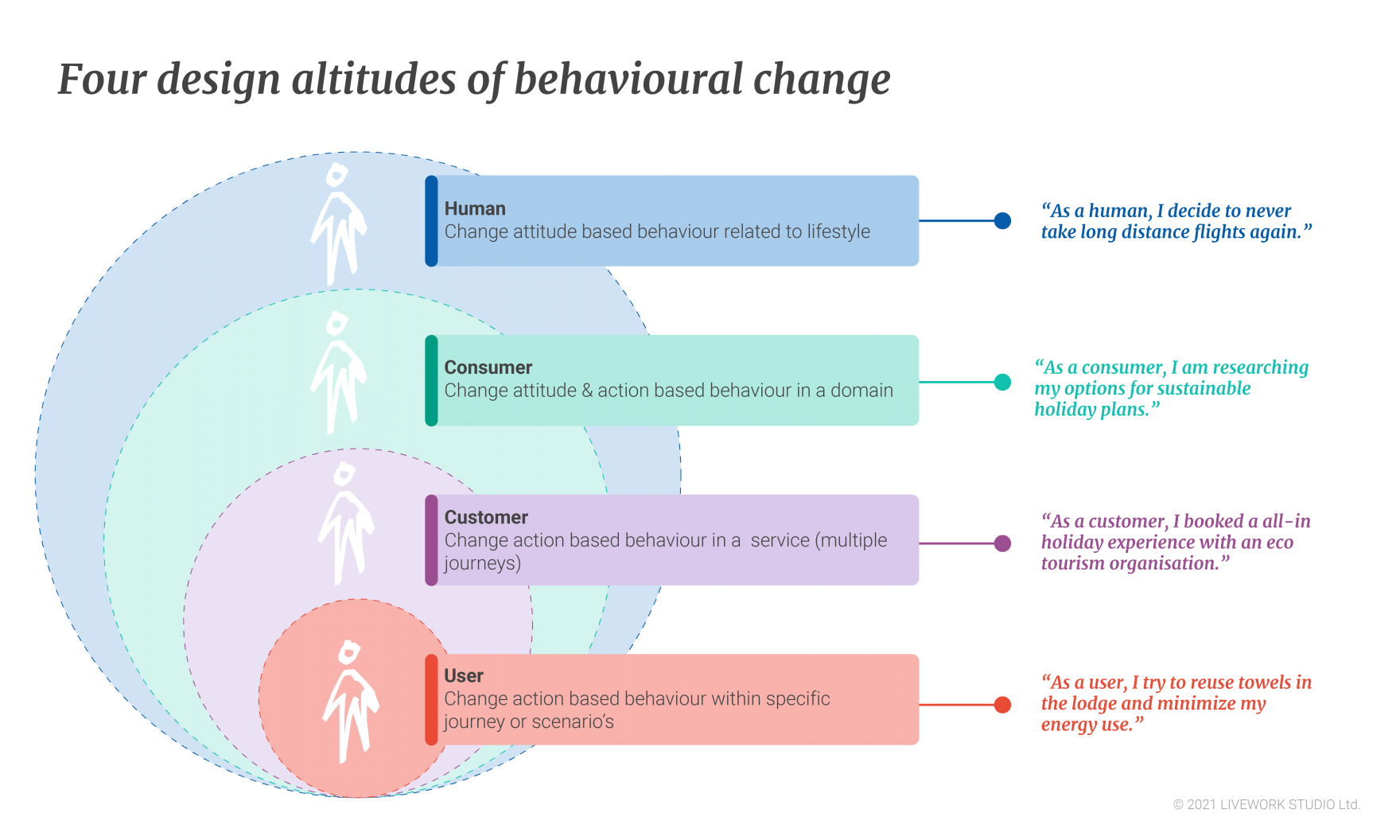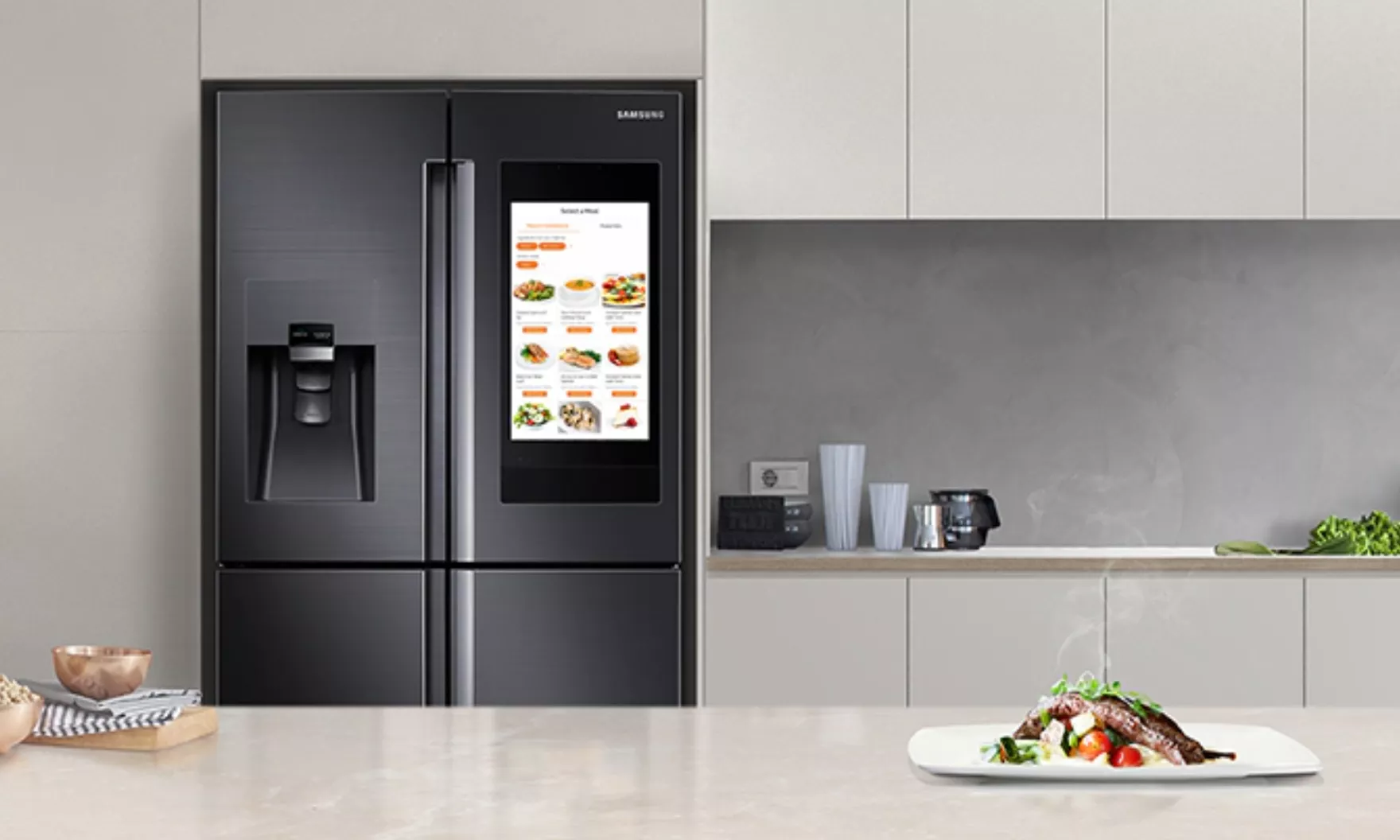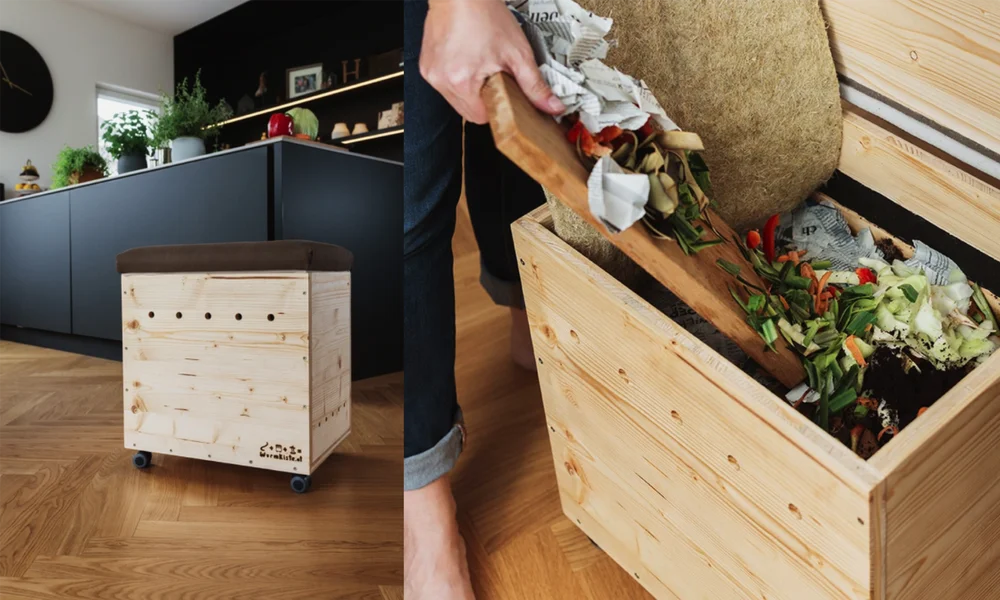Behaviour is a broad term – covering a wide range of actions, attitudes and roles, from the minutiae of the interaction with one touchpoint to the magnitude of a fundamental lifestyle change (e.g. switching to vegan). Governments and businesses will find that it is useful to identify at what level or altitude they would like people to change their behaviour to be more sustainable. In this blogpost we unpack the 4 altitudes we distinguish at Livework: User, Customer, Consumer and Human. To illustrate each altitude we will show examples of how designing on each one of them translates to different solutions to the same sustainability challenge: food waste.
 The altitude at which people’s behaviour should be addressed matters for finding the right solution. We distinguish four attitudes – from user, customer, consumer to human.
The altitude at which people’s behaviour should be addressed matters for finding the right solution. We distinguish four attitudes – from user, customer, consumer to human.
Behaviour change at the user altitude
When we talk about designing for users, we are talking about people’s behaviour concerning a (digital) product or touchpoint. This altitude zooms in on our interaction with a specific part of the service or product to get something done. This can be our interaction with an app/website or on our choices standing in front of a supermarket shelf.
At this altitude, you can not tackle the entire food waste problem. But it is the right altitude to (re)design how people interact with a (new) touchpoint. Take for example Samsung’s Smart Fridge Freezers[1]. This fridge helps its users to plan their meals, and minimize waste by keeping track of their stock and suggesting recipes to use up food that is about to expire. Although it is just one touchpoint, if it is designed well (e.g. it is easy to keep stock), it can yield behavioural impact beyond just the app use as users are invited to minimize their food waste in general.
“The Samsung Smart Fridge Freezer helps me to keep track of the food I bought and makes sure I know when food will go off.”
 The Samsung Family Hub™ Multi-door Fridge Freezer helps users to keep a digital inventory of their kitchen cupboards and notifies when food will go off [1].
The Samsung Family Hub™ Multi-door Fridge Freezer helps users to keep a digital inventory of their kitchen cupboards and notifies when food will go off [1].
Behaviour change at the customer altitude
One altitude higher, the customer level describes people’s attitude and interaction with an organisation or company. This is about all interactions across touchpoints (e.g. a supermarket’s app, physical store and website) working well together and about the value proposition. On the customer level, behaviour is strongly influenced by factors like value for money, customer recognition, accessibility or ease of setup. This is the altitude to design for decisions to acquire, adapt, replace or switch value providers. It is especially relevant to design at this altitude if the customer – the one who pays – is different from the user (which is a typical situation for households).
To show what designing at this altitude means, let’s take a look at the ‘Pieter Pot’ service. Pieter Pot is a package-free grocery service that delivers food in glass jars. The value proposition requires customers to significantly change their purchasing behaviour. They have to order a selection of products online (Pieter Pot’s product range is significantly smaller than that of most supermarkets), store their food in the glass jars provided and return the empty jars after use. Designing the service well to help customers make this transition more easily will make or break its adoption.
“When I switched to the ‘packaging-free’ online supermarket Pieter Pot, I changed the way I buy, store and re-stock my pantry.”
 Pieter Pot is a package-free grocery service. Customers are asked to store their food in glass jars and receive updates on how much plastic has been saved with the Pieter Pot service: “Together we saved 180.000 plastic packages [3]!”
Pieter Pot is a package-free grocery service. Customers are asked to store their food in glass jars and receive updates on how much plastic has been saved with the Pieter Pot service: “Together we saved 180.000 plastic packages [3]!”
Behaviour change at the consumer altitude
The consumer perspective informs about how people behave in a specific domain (e.g. energy, groceries, holidays). How they make decisions about how and with whom they will fulfil their needs. For instance the domain of food management in general. This altitude describes behaviour across value providers (e.g. grocery store, farmers market and take away). Designing on this level starts with understanding how choices are made: how do people interact with this range of suppliers and what influences or changes their attitude and behaviour? On this level, you can design for a change in attitude and attract attention to alternative options to satisfy a need.
“As my municipality does not collect organic waste, I decided to look for alternatives and I started an indoor worm composting system with a bin that fits in my apartment.”
 As an alternative for curb-side organic waste collection and larger composting systems, WormKiste provides an easy to use composting system where worms turn organic waste into fertilizer - in a compact stool [4].
As an alternative for curb-side organic waste collection and larger composting systems, WormKiste provides an easy to use composting system where worms turn organic waste into fertilizer - in a compact stool [4].
Behaviour change at the human altitude
Human decisions are often emotional and are shaped by their experience, oftentimes unrelated to the product and service offered, and can change after a life event. At the human altitude, we look at behaviour in the context of people’s lives. Designing on this altitude is useful to spot gaps in the market and innovate new propositions. This altitude is also suitable to design for a general human experience, regardless of specific products or services people use.
“I realized that I was wasting a lot of food when I moved to another county and had to start collecting my green waste separately.”
Understand whether your challenge is a human, consumer, customer or user challenge
Understanding at what level you want to ignite change is crucial. Changing an entire city’s attitude towards waste is very different from trying to get people to purchase food about to expire. Understand the people you would like to address. Understand them as humans, as consumers, as customers and as users: What makes them tick, what do they need and how could that align to your sustainability ambitions.
Want to know more about designing for the human side of sustainability challenges? Check out our latest article on The human challenge in designing for sustainability
References
[1] Samsung. (2021). Smart Fridge Freezers.
[2] van der Vleuten, O. & PCZ. (2020, May 1). Nostalgische potten van verpakkingsvrije supermarkt Pieter Pot veroveren. PZC Zeeuws Niews.
[3] Wormenbak: Eenvoudig composteren met een stijlische kruk. (2021, February 11). Wormenkrukje.nl.

As a service designer and researcher, my main aim is to design positive experiences for people. I have a background in design, research and strategy and have a curious and creative mindset.

